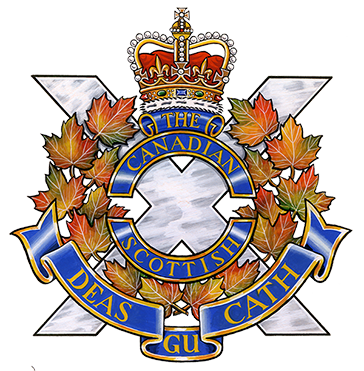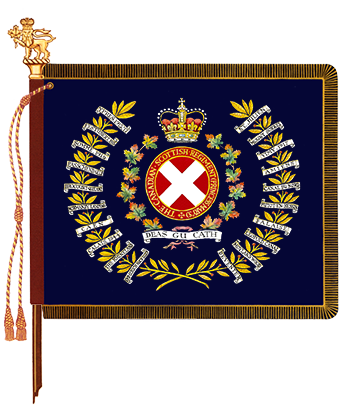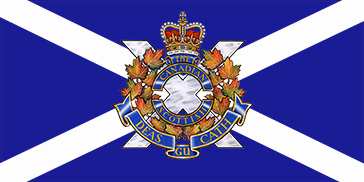The Canadian Scottish Regiment (Princess Mary's)
The official lineage of The Canadian Scottish Regiment (Princess Mary's) infantry regiment.

Colonel-in-Chief: Her Royal Highness Princess Alexandra, The Honourable Lady Ogilvy LG GCVO CD
Badge
Description
A saltire Argent surmounted by a scroll above an annulus fracted in fess all Azure edged and inscribed "THE", "CANADIAN" and "SCOTTISH" in letters Or, ensigned by the Royal Crown, environed by a wreath of sixteen autumnal maple leaves proper, and surmounted in base by a scroll Azure fimbriated and inscribed with the Motto in letters Or.
Symbolism
The sixteen maple leaves are a reference to the service of the 16th Battalion of the Canadian Expeditionary Force during the First World War. The maple leaves represent service to Canada, and the Crown, service to the Sovereign. The saltire or cross of St. Andrew, the patron saint of Scotland, is a common device among badges of highland infantry regiments. The words "THE CANADIAN SCOTTISH" are a form of the regimental title and "DEAS GU CATH" is the motto of the regiment.
Motto
DEAS GU CATH (Ready for the fray)
March
"Blue Bonnets Over the Border"
Alliance
British Army
The Royal Regiment of Scotland
Regimental colour

Camp flag

Battle honours
The First World War
YPRES, 1915, '17; Gravenstafel; St. Julien; FESTUBERT, 1915; MOUNT SORREL; SOMME, 1916; Pozières; Flers-Courcelette; Thiepval; Ancre Heights; Ancre, 1916; ARRAS, 1917, '18; Vimy, 1917; Arleux; Scarpe, 1917, '18; HILL 70; Passchendaele; AMIENS; Drocourt-Quéant; HINDENBURG LINE; Canal du Nord; PURSUIT TO MONS; FRANCE AND FLANDERS, 1915-18.
Honorary Distinction
Oak leaf shoulder badge for the actions of the 16th "Overseas" Battalion, CEF, at Kitchener's Wood on 22/23 April 1915.
The Second World War
NORMANDY LANDING; Putot-en-Bessin; CAEN; The Orne; FALAISE; The Laison; Calais, 1944; THE SCHELDT; Leopold Canal; Breskens Pocket; THE RHINELAND; Waal Flats; Moyland Wood; THE RHINE; Emmerich-Hoch Elten; Deventer; Wagenborgen; NORTH-WEST EUROPE, 1944-1945.
South-West Asia
AFGHANISTAN
Lineage
This Reserve Force regiment originated on 3 September 1912 and incorporates the following regiments and artillery battery.
The Canadian Scottish Regiment (Princess Mary's) originated in Victoria, British Columbia on 3 September 1912, when the '88th Regiment Victoria Fusiliers' was authorized to be formed.Footnote 1 On 12 March 1920, it was amalgamated with the '50th Regiment "Highlanders"' (see below) and redesignated 'The Canadian Scottish Regiment'.Footnote 2 It was redesignated: '3rd (Reserve) Battalion, The Canadian Scottish Regiment' on 7 November 1940;Footnote 3 '3rd (Reserve) Battalion, The Canadian Scottish Regiment (Machine Gun)' on 26 March 1942;Footnote 4 'The Canadian Scottish Regiment' on 1 April 1946;Footnote 5 and 'The Canadian Scottish Regiment (Princess Mary's)' on 29 April 1948.Footnote 6 On 31 December 1954, it was amalgamated with the '66th Light Anti-Aircraft Regiment, RCA' (see below) and the '62nd Anti-Tank Battery (Self-Propelled), RCA' (see below), retaining its designation.Footnote 7
Notes:
Upon redesignation as The Canadian Scottish Regiment on 12 March 1920 (see above), it was organized as a five battalion regiment with the 1st Battalion (16th Battalion, CEF) on the Non Permanent Active Militia order of battle and the 2nd Battalion (48th Battalion, CEF), 3rd Battalion (67th Battalion, CEF), 4th Battalion (88th Battalion, CEF), and 5th Battalion (143rd Battalion, CEF) on the Reserve order of battle.
The Canadian Scottish Regiment was disbanded for the purpose of reorganization on 1 December 1920 and reorganized the same day (GO 18/21). This change was administrative and does not affect the lineage of the regiment.
On 1 August 1930, The Canadian Scottish Regiment was reorganized as a six battalion regiment with the 1st Battalion (16th Battalion, CEF) and 2nd Battalion (88th Battalion, CEF) (see below) on the Non Permanent Active Militia order of battle and the 3rd Battalion (67th Battalion, CEF), 4th Battalion (48th Battalion, CEF), 5th Battalion (143rd Battalion, CEF), and 6th Battalion (103rd Battalion, CEF) on the Reserve order of battle. (GO 97/30). The reserve units were disbanded on 14 December 1936 (GO 3/37).
On 1 April 1946, The Canadian Scottish Regiment was reorganized as a one battalion regiment (GO 115/46).
On 4 May 1951, the regiment mobilized two temporary Active Force companies designated "E" and "F" Company (CAO 110-2, Pt 'B', Supp Issue No. 245/51; and SD 1 Letter No. 4237, 5 May 1951). "E" Company was reduced to nil strength upon its personnel being incorporated into the '1st Canadian Highland Battalion' for service in Germany with the North Atlantic Treaty Organization (SD 1 Letter No. 4365, 12 November 1951). It was disbanded on 29 July 1953 ( CAO 78-2, Pt 'B', Supp Issue No. 352/53). "F" Company was initially used as a reinforcement pool for "E" Company. On 15 May 1952, it was reduced to nil strength, upon its personnel being absorbed by the newly formed '2nd Canadian Highland Battalion' for service in Korea with the United Nations (SD 1 Letter No. 4452, 22 April 1952; and CAO 110-2, Pt 'B', Supp Issue No. 283/52). "F" Company was disbanded on 29 July 1953 (CAO 78-2, Pt 'B', Supp Issue No. 352/53).
The 50th Regiment originated in Vancouver, British Columbia on 15 August 1913, when an "8 company Highland Regiment of Infantry" was authorized to be formed.Footnote 8 It was designated the '50th Regiment "Highlanders"' on 21 November 1913.Footnote 9 On 12 March 1920, it was amalgamated with the '88th Regiment Victoria Fusiliers', as above.
The 66th Light Anti-Aircraft Regiment, RCA originated in Nanaimo, British Columbia on 1 August 1930, when the '2nd Battalion, The Canadian Scottish Regiment' was authorized to be formed.Footnote 10 On 15 December 1936, it was amalgamated with '"A" Company, 11th Machine Gun Battalion, CMGC' and redesignated '2nd Battalion (Machine Gun), The Canadian Scottish Regiment'.Footnote 11 It was redesignated: '2nd (Reserve) Battalion (Machine Gun), The Canadian Scottish Regiment' on 7 November 1940;Footnote 12 '2nd Battalion, The Canadian Scottish Regiment' on 1 January 1941;Footnote 13 and '2nd (Reserve) Battalion, The Canadian Scottish Regiment' on 15 October 1943.Footnote 14 On 1 April 1946, it was converted to artillery and redesignated the '66th Light Anti-Aircraft Regiment (Canadian Scottish Regiment), RCA'.Footnote 15 On 31 December 1954, it was amalgamated with the 'The Canadian Scottish Regiment (Princess Mary's)' and the '62nd Anti-Tank Battery, RCA', as above.
Notes:
The 2nd Battalion, The Canadian Scottish Regiment was disbanded for the purpose of amalgamation with the '"A" Company, 11th Machine Gun Battalion, CMGC' on 14 December 1936 (as above) and reorganized the next day. This change was administrative and does not affect the lineage of the regiment.
On 14 December 1936, ‘The British Columbia Hussars’ amalgamated with ‘Headquarters’ and “B” Company’, 11th Machine Gun Battalion, CMGC’ and “C” Company, 11th Machine Gun Battalion, CMGC’ was amalgamated with ‘The Westminster Regiment’, now ‘The Royal Westminster Regiment’ (GO 178/36). The 11th Machine Gun Battalion, CMGC (1 June 1919 to 14 December 1936) was not perpetuated (GO 76/37).
The 62nd Anti-Tank Battery (Self-Propelled), RCA originated in Duncan, British Columbia on 2 February 1920, when the '62nd Field Battery (Howitzer), CFA' was authorized to be formed.Footnote 16 It was redesignated: '62nd Field Battery, CA' on 1 July 1925;Footnote 17 '62nd Field Battery (Howitzer), RCA' on 3 June 1935;Footnote 18 '62nd (Reserve) Field Battery (Howitzer), RCA' on 7 November 1940;Footnote 19 and '62nd Anti-Tank Battery (Self-Propelled), RCA' on 1 April 1946.Footnote 20 On 31 December 1954, it was amalgamated with 'The Canadian Scottish Regiment (Princess Mary's)' and the '66th Light Anti-Aircraft Regiment (Canadian Scottish Regiment), RCA', as above.
Perpetuations
'16th', '48th', '67th', '88th', '103rd' and '143rd "Overseas" Battalion(s), CEF'
Headquarters Location
Victoria , British Columbia
Operational history
The First World War
The 50th Regiment "Highlander" was placed on active service on 6 August 1914 for local protection duties.Footnote 21
The 88th Regiment Victoria Fusiliers was placed on active service on 6 August 1914 for local protection duties.Footnote 22
The 16th Battalion, which was authorized on 1 September 1914 as the '16th Battalion, CEF',Footnote 23 embarked for Britain on 28 September 1914.Footnote 24 It disembarked in France on 15 February 1915, where it fought as part of the 3rd Infantry Brigade, 1st Canadian Division in France and Flanders until the end of the war.Footnote 25 The battalion was disbanded on 30 August 1920.Footnote 26
The 48th Battalion, which was authorized on 7 November 1914 as the '48th Battalion, CEF',Footnote 27 embarked for Britain on 1 July 1915.Footnote 28 It was converted to pioneer and redesignated: '3rd Canadian Pioneer Battalion, CEF' on 6 January 1916.Footnote 29 It disembarked in France on 9 March 1916, where it served as part of the 3rd Canadian Division in France and Flanders until 17 April 1917, when its personnel were absorbed by the Canadian Corps in the field.Footnote 30 The battalion was disbanded on 30 August 1920.Footnote 31
The 67th Battalion, which was authorized on 20 April 1915 as the '67th "Overseas" Battalion, CEF',Footnote 32 embarked for Britain on 1 April 1916.Footnote 33 It was converted to pioneer and redesignated the '67th Canadian (Pioneer) Battalion, CEF' on 15 May 1916.Footnote 34 It disembarked in France on 14 August 1916, where it served as part of the 4th Canadian Division in France and Flanders until 28 April 1917, when its personnel were absorbed by the Canadian Corps in the field.Footnote 35 The battalion was disbanded on 30 August 1920.Footnote 36
The 88th Battalion, which was authorized on 22 December 1915 as the '88th "Overseas" Battalion, CEF',Footnote 37 embarked for Britain on 31 May 1916.Footnote 38 It provided reinforcements for the Canadian Corps in the field until 18 July 1916, when its personnel were absorbed by the '30th Reserve Battalion, CEF'.Footnote 39 The battalion was disbanded on 1 September 1917.Footnote 40
The 103rd Battalion, which was authorized on 22 December 1915 as the '103rd "Overseas" Battalion, CEF',Footnote 41 embarked for Britain on 23 July 1916.Footnote 42 It provided reinforcements for the Canadian Corps in the field until 7 January 1917, when its personnel were absorbed by the '16th Reserve Battalion, CEF'.Footnote 43 The battalion was disbanded on 1 September 1917.Footnote 44
The 143rd Battalion, which was authorized on 22 December 1915 as the '143rd "Overseas" Battalion, CEF',Footnote 45 embarked for Britain on 17 February 1917.Footnote 46 Its personnel were absorbed by the '24th Reserve Battalion, CEF' and the 'Canadian Railway Troops Training Depot' on 15 March 1917 to provide reinforcements to the Canadian Corps in the field.Footnote 47 The battalion was disbanded on 4 April 1918.Footnote 48
The Second World War
Details from the 1st Battalion were called out on service on 26 August 1939 and then placed on active service on 1 September 1939, under the designation '1st Battalion, The Canadian Scottish Regiment, CASF (Details)', for local protection duties.Footnote 49 The details called out on active service were disbanded on 31 December 1940.Footnote 50 Details from the 2nd Battalion were placed on active service on 1 September 1939, under the designation '2nd Battalion, The Canadian Scottish Regiment (Machine Gun), CASF (Details)', for local protection duties.Footnote 51 The details called out on active service were disbanded on 31 December 1940.Footnote 52
The regiment mobilized the '1st Battalion, The Canadian Scottish Regiment, CASF' for active service on 24 May 1940.Footnote 53 It embarked for Britain on 25 August 1941.Footnote 54 On D-Day, 6 June 1944, it landed in Normandy, France, as part of the 7th Infantry Brigade, 3rd Canadian Infantry Division, and it continued to fight in North-West Europe until the end of the war.Footnote 55 The overseas battalion was disbanded on 15 January 1946.Footnote 56
The regiment subsequently mobilized the 2nd (Reserve) Battalion as the '2nd Battalion, The Canadian Scottish Regiment, CASF' for active service on 1 January 1941.Footnote 57 It served in Canada in a home defence role as part of the 13th Infantry Brigade, 6th Canadian Division.Footnote 58 The battalion was disbanded on 15 October 1943.Footnote 59
On 1 June 1945, a third Active Force component of the regiment, designated '4th Battalion, The Canadian Scottish Regiment, CIC, CAOF' was mobilized for service in the Canadian Army Occupational Force in Germany.Footnote 60 The battalion was disbanded on 29 April 1946.Footnote 61
Details from the 62nd Field Battery, RCA were placed on active service on 1 September 1939, under the designation '62nd Field Battery (H), RCA, CASF (Details)', for local protection duties.Footnote 62 The details called out on active service were disbanded on 31 December 1940.Footnote 63
The 62nd Field Battery, in conjunction with the '44th Field Battery, RCA' mobilized the '44th/62nd Field Battery, RCA, CASF' for active service on 24 May 1940.Footnote 64 This unit was reorganized as two separate batteries on 1 January 1941, designated the '44th Field Battery, RCA, CASF' and the '62nd Field Battery, RCA, CASF'.Footnote 65 It was redesignated the '62nd Light Anti-Aircraft Battery, RCA, CASF' the same day.Footnote 66 The battery provided light anti-aircraft artillery support as part of the '11th Light Anti-Aircraft Regiment, RCA, CASF', 1st Canadian Anti-Aircraft Brigade in Great Britain.Footnote 67 The overseas battery was disbanded on 1 March 1944.Footnote 68
South-West Asia
From 2002 to 2014, the Canadian Scottish Regiment (Princess Mary's) reinforced various CAF units deployed to Afghanistan.Footnote 69
Page details
- Date modified: